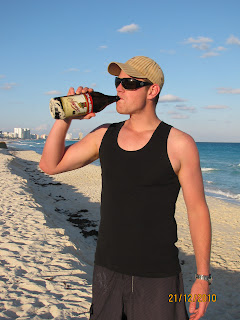Uxmal
People have differing reactions to the idea of visiting the ruins of ancient cities. "Seen one pile of old rocks, you've seen them all," some sigh dismissively, while others are entranced, and spend hours staring at temples and stone carvings.
My level of interest lies somewhere between the two extremes. I'm glad we visited two Mayan sites in the Yucatan - the massive Chichen Itza and the smaller, but more exquisitely decked out Uxmal. The main temple pyramid buildings were pretty similar at the sites, but they had different decorating techniques.
Most, predictably, centred around religion - temples, places to hold funerals, places to bury people. But the Mayans had other interests, including astrology and bloodsports. Both sites had the remains of sports pitches, encased by long corridors - apparently to increase the echo factor so you could shout at people and be heard on the pitch. Stone rings were built on the walls as the goals. All sounds pretty much like soccer or basketball, except they used to decapitate people a lot.
Mutilation is a pretty recurrent theme in some of the other designs on buildings. A popular motif was a carving of an eagle holding a human heart in its enormous talon. And like most other ancient cultures, human sacrifice was popular. To this end there are entire walls decorated with surprised-looking skulls.
Eagle holding human heart
Chichen Itza was a much bigger site, with many different buildings spread over a bigger area, but Uxmal's buildings were made of a fetching salmon-hued stone, and I found the crazy geometric glyph writing more interesting here.
Of course, when visiting these places its not just about the architecture, there's always some entertaining people-watching to be had. Like this lady, who so liked the concept of donning a sun umbrella she bought a hat with one on it.
Chichen Itza was pretty empty in the morning but enormous groups of package-tour people began to pour in and by lunchtime the place was a zoo. The paths were brimming with handicraft sellers (they seem to follow the package-tour types around), calling out to us "special price....almost free!"
A small wooden jaguar's head, which if you blew into it made a callous hissing that is meant to sound like the super-cat, was a popular item. The thing is you need enough air in your lungs to make it sound convincing, otherwise it sounds like an asthmatic cough. They started to get pretty annoying as people stupidly bought them for their kids - enough to make the vuvuzela sound as delicate as a violin.
The most hilarious handicraft of the day played on the phallus theme - a common feature in the carvings at both sites. This one is actually an instrument, and is being played like a Xylophone.

















































